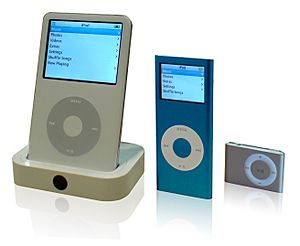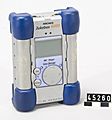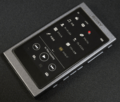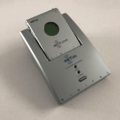MP3 player facts for kids
An MP3 player is a small, portable device that lets you listen to your favorite songs wherever you go! It's like having a tiny music library in your pocket. These devices play music files that are saved in a special format called MP3.
MP3s are audio files that have been made smaller. This is done by carefully removing sounds that the human ear usually can't hear. This way, many songs can fit onto one player. You can connect an MP3 player to a computer using a USB cord or Wi-Fi. This lets you easily transfer music and other computer files to the player's internal memory.
Many newer MP3 players can do more than just play music. They can also let you view pictures, watch movies, or even play simple games. One of the most famous MP3 players ever made is the iPod.
Contents
What is an MP3 Player?
An MP3 player is a type of portable audio player. It's designed to store and play digital music files. The main type of file it plays is the MP3 format. These players became very popular because they let people carry hundreds or even thousands of songs with them.
How MP3 Files Work
The term "MP3" stands for MPEG-1 Audio Layer III. It's a way to compress, or make smaller, audio files. Imagine a big music file; an MP3 makes it much smaller without losing too much sound quality. This is important because smaller files take up less space on the player. This means you can store more songs!
Connecting and Transferring Music
To get music onto your MP3 player, you usually connect it to a computer. This can be done with a USB cable. Some newer players might even connect using Wi-Fi. Once connected, you can drag and drop music files from your computer to the player. Software programs often help you manage your music library and sync it with your player.
Beyond Music: Other Features
While playing music is their main job, many MP3 players offer extra features.
- Videos and Photos: Some players have screens that let you watch short videos or look at your photos.
- Games: Simple games can sometimes be played on these devices.
- Radio: Many include an FM radio tuner.
- Voice Recording: Some have built-in microphones to record voices or notes.
History of MP3 Players
The idea of portable music players isn't new. People used to carry around cassette players and then CD players. But these were bulky and could only hold a limited amount of music.
Early Digital Players
The first true MP3 players started appearing in the late 1990s. One of the earliest was the Rio PMP300, released in 1998. These early players had small storage capacities, often only enough for a few dozen songs. They were also quite expensive.
The Rise of the iPod
In 2001, Apple introduced the iPod. This player changed everything. It was easy to use, looked cool, and could hold thousands of songs thanks to its small hard disk drive. The iPod, along with iTunes, Apple's music software, made digital music very popular.
Flash vs. Hard Drive Players
MP3 players generally use two main types of storage:
- Flash-based players: These use flash memory, like a USB stick. They are usually smaller, lighter, and more durable because they have no moving parts. The iPod Shuffle is an example.
- Hard drive-based players: These use tiny hard drives, similar to those in computers. They can store much more music but are usually a bit larger and more fragile. The iPod Classic used a hard drive.
Images for kids
-
A flash-based player (Creative MuVo)
-
An MP3 CD player (Philips Expanium)
-
The third generation iPod stores audio files on a miniature hard disk drive.
-
The Iriver SPINN portable media player features Samsung storage and a Telechips processor. It also features both touchscreen and a clickwheel mechanism for navigation. The SPINN implements haptic feedback by vibrating with user input. Additional hardware capabilities enable it to decode the MPEG-4 Part 2 format and play back audio using SRS WOW.
-
An iPod Shuffle DAP, featuring no display screen
See also
 In Spanish: Reproductor de audio digital para niños
In Spanish: Reproductor de audio digital para niños




















